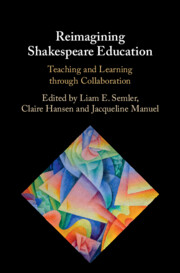Book contents
- Reimagining Shakespeare Education
- Reimagining Shakespeare Education
- Copyright page
- Dedication
- Contents
- Figures
- Tables
- Notes on Contributors
- Acknowledgements
- Introduction
- Part I Reimagining Shakespeare with/in Schools
- Part II Reimagining Shakespeare with/in Universities
- Part III Public Reimaginings
- Part IV Digital Reimaginings
- Part V Reimagining Performance
- Introduction
- Chapter 17 Flute Theatre, Shakespeare and Autism
- Chapter 18 The Viola Project
- Chapter 19 ‘All Corners Else o’th’Earth Let Liberty Make Use Of’
- Chapter 20 Teaching Shakespeare in Oman
- Chapter 21 Edward’s Boys in the South of France
- Afterword
- Index
- References
Chapter 20 - Teaching Shakespeare in Oman
Exploring Shared Humanity and Cultural Difference through Shakespeare’s Texts
from Part V - Reimagining Performance
Published online by Cambridge University Press: 02 February 2023
- Reimagining Shakespeare Education
- Reimagining Shakespeare Education
- Copyright page
- Dedication
- Contents
- Figures
- Tables
- Notes on Contributors
- Acknowledgements
- Introduction
- Part I Reimagining Shakespeare with/in Schools
- Part II Reimagining Shakespeare with/in Universities
- Part III Public Reimaginings
- Part IV Digital Reimaginings
- Part V Reimagining Performance
- Introduction
- Chapter 17 Flute Theatre, Shakespeare and Autism
- Chapter 18 The Viola Project
- Chapter 19 ‘All Corners Else o’th’Earth Let Liberty Make Use Of’
- Chapter 20 Teaching Shakespeare in Oman
- Chapter 21 Edward’s Boys in the South of France
- Afterword
- Index
- References
Summary
Working in different countries provides huge learning opportunities for theatre practitioners in understanding the capacity of drama pedagogies to uncover deep human connections beneath more superficial cultural differences, and to learn ways of negotiating the obstacles those cultural differences create. As recent years have brought more focus on both the social justice imperatives and the overall value of diversity and inclusion across schools and societies, the need to connect across cultures becomes ever more important. In this chapter we describe the journeys of our work exploring Shakespeare through intercultural dialogue with Omani colleagues. We describe the content and timeline of two interlinked multiphase education projects on Shakespeare with Omani teachers and students: the first with the Royal Shakespeare Company, which began as part of an education enquiry for the World Shakespeare Festival in 2012, and the second with Butterfly Theatre Collective, a small Meisner rooted company who specialise in exploring the uniqueness of every performance and performer. We offer a comparison of the practicalities in carrying out similar projects with two very different arts companies, and share the conceptual and emotional learning we found through our associations with Omani teachers, directors, actors and young people.
- Type
- Chapter
- Information
- Reimagining Shakespeare EducationTeaching and Learning through Collaboration, pp. 307 - 318Publisher: Cambridge University PressPrint publication year: 2023



